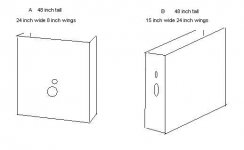I have 3-way speakers with low crossover in baffle step region - about 350 Hz. Changed filter connections, so midrange and tweeter ares connecteed to same cable posts.
Biamped them and played with upper amp volume. At certain level sound suddenly became much more real. Can't say how many dB-s the drop is. From the ear I's say 1,5 - 2 dB.
To my hearing most commercial sprekers have a drop between 100 - 500 hZ. Upper part may be very clean and realistic, but overall not real. And then bass sounds from under 100 Hz suddenly jump up. But many people don't share my view and are happy with the usual stuff, including for example guys who design Audes speakers.
Biamped them and played with upper amp volume. At certain level sound suddenly became much more real. Can't say how many dB-s the drop is. From the ear I's say 1,5 - 2 dB.
To my hearing most commercial sprekers have a drop between 100 - 500 hZ. Upper part may be very clean and realistic, but overall not real. And then bass sounds from under 100 Hz suddenly jump up. But many people don't share my view and are happy with the usual stuff, including for example guys who design Audes speakers.
tmblack said:When is baffle step compensation step necessary?
I haven't heard of many commercial speakers using this technique.
Tom
Any time the baffle isn't big enough to reinforce the bass like it does the midrange. IOW allmost any two way.
A three way is often a better solution if you want to keep the sensitivity high. Maybe double 12's or a single 15 side firing in a deep but narrow cabinet crossed where the mid starts falling off from the narrow front baffle?
Many commercial 2/ways use it. That's why most are power suckers. (96 db or lower sensitivity)
Anytime when any kind of baffle/box is used. There are various techniques how to do. One of them was written by Ola. You can also attenuate higher frequencies or boost lower ones independetly on xover freq..When is baffle step compensation necessary?
tmblack said:My speakers are each 42cm wide and the bass measures reasonable flat withoiut such compensation.
Does B&W uses it in the top models?
Tom
Hi Tom, what driver and tuning and how do you measure them? Are they very sensitive at 30 cycles?
Thanks
The answer to such a simple question is really complicated. Whenever you try and do a BSC, you also change the phase response, and that changes sound. Dave pointed a good starting point, but don't take formulas for granted, otherwise you will end up with an opinion like a "blind man's impressions of an elephant".
BSC should be used if you find a problems that looks like it could be solved by using some sort of BSC. The less you have to put between the amp and the driver, the better. Since BSC depends on location of drivers, shape of baffle, and the response before using BSC, It really might not be a good idea to assume you have a baffle step problem just based on dimensions.
Case B will result in significantly lower bass than case A. With case B the rear wave must travel 48" more distance than the front wave, although a significant amount will take the short cut over the top. With case A the additional distance is only about 24". With B though you will change the radiation patern toward cartoid and your wings will need extensive bracing because significant pressures will be exerted on them.
chris ma said:Hello there,
If I go with case B and using active bi-amping do I still need to use BSC?
BTW I am also using H-frame dipole subs for 60hz down, not expecting OB case B to produce too low bass.
bi-amping is a little tricky. First you need to compensate for impedance variation, then listen and measure to determine if BSC is needed. If BSC is needed, you will most likely have to implement it prior to bi-amp.
and because you are not in acousticaly dead room you have to useI am using DIY speakers and testing using MLS technique, mic spaced 50" from speaker
. That's whyClose mic 1/4" from bass driver
bass driver would not show any baffle effects
BS is existing phenomenon in case I mentioned and can be corrected as was written. In theory has magnitude of 6dB, usually shows less /say 2-4dB/ because is masked by reverbant sound field in listening room according to box and ear position.
Take a look at anaechoic measurement or another one. They shows 6dB BS with central freq. 350Hz or 650Hz respectively /different boxes were used/
Don't be scared. The sound quality is not always an issue in the market. Production of B+W and vast majority of other producers are led by marketing dpt. not by technical.I haven't heard of many commercial speakers using this technique.
So long
 M.
M.- Status
- This old topic is closed. If you want to reopen this topic, contact a moderator using the "Report Post" button.
- Home
- Loudspeakers
- Multi-Way
- When to use baffle step compensation?
